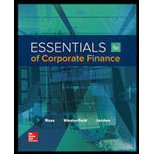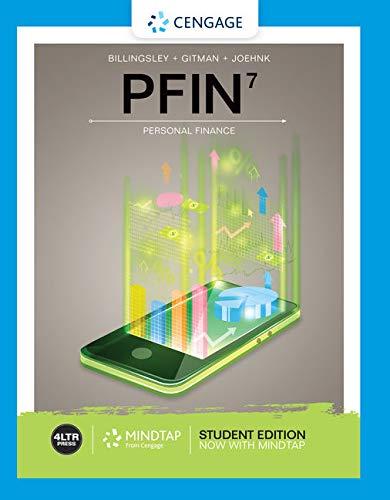
ESSENTIALS CORPORATE FINANCE + CNCT A.
9th Edition
ISBN: 9781259968723
Author: Ross
Publisher: MCG CUSTOM
expand_more
expand_more
format_list_bulleted
Question
Chapter 10, Problem 15QP
Summary Introduction
To determine: The annual percentage return (APR) of the investment.
Introduction:
Any percentage of
Summary Introduction
To determine: The effective annual interest rate (EAR).
Introduction:
The effective annual interest rate (EAR) is the rate earned or paid on an investment, or any loans on an annual
Expert Solution & Answer
Want to see the full answer?
Check out a sample textbook solution
Students have asked these similar questions
Use the financial statement of DKT Enterprise provided above to calculate the ratio for 2024 that reflects each of the following conditions (where applicable, round off answers to two decimal places.):
1. The percentage of DKT Enterprises' revenue that remained after accounting for the cost of goods sold.
2. The percentage of DKT Enterprises' revenue that remained after all expenses, including operating costs, interest, and taxes, have been deducted.
3. The extent to which DKT Enterprises' short-term liabilities, were covered by assets that could be quickly converted into cash during the year.
4. The ratio of DKT Enterprises' liquid assets to its current liabilities, indicating the company's ability to meet short-term obligations without relying on inventory.
5. The percentage of the profit DKT Enterprises generated from its total assets during the year, reflecting how efficiently it utillises its asset base to generate earnings.
6. The percentage of the profit for the year relative…
Dynamic Energy Wares (DEW) has decided to change the manner in which it distributes its products to large companies. The change in the distribution system comes at a time when DEW’s profits are declining. The declining profits might not be the sole reason for the change, but it appears to be the primary impetus for the decision. It also appears that the new policy requiring DEW’s distributors to increase inventory levels before the end of the fiscal year will artificially inflate DEW’s sales for the current year. However, DEW’s new policy does not require the distributors to pay for any increased inventory until next year (six months), and any unsold inventory can be returned after nine months. So, if the demand for DEW’s products actually is decreasing, the impact will appear on next year’s financial statements. If the financial manager actually intends to artificially inflate DEW’s profits this year, she must realize that such actions eventually will “catch up” with her.
Discussion…
what is distributors’ meeting?
Chapter 10 Solutions
ESSENTIALS CORPORATE FINANCE + CNCT A.
Ch. 10.1 - Prob. 10.1ACQCh. 10.1 - Why are unrealized capital gains or losses...Ch. 10.1 - What is the difference between a dollar return and...Ch. 10.2 - Prob. 10.2ACQCh. 10.2 - Prob. 10.2BCQCh. 10.2 - Prob. 10.2CCQCh. 10.2 - Prob. 10.2DCQCh. 10.2 - Prob. 10.2ECQCh. 10.2 - Prob. 10.2FCQCh. 10.3 - What do we mean by excess return and risk premium?
Ch. 10.3 - Prob. 10.3BCQCh. 10.3 - Prob. 10.3CCQCh. 10.3 - What is the first lesson from capital market...Ch. 10.4 - In words, how do we calculate a variance? A...Ch. 10.4 - Prob. 10.4BCQCh. 10.4 - Prob. 10.4CCQCh. 10.4 - What is the second lesson from capital market...Ch. 10.5 - Prob. 10.5ACQCh. 10.5 - Prob. 10.5BCQCh. 10.6 - What is an efficient market?Ch. 10.6 - Prob. 10.6BCQCh. 10 - Section 10.1Say you buy a share of stock for 50....Ch. 10 - Prob. 10.3CCh. 10 - Prob. 10.4CCh. 10 - Prob. 10.5CCh. 10 - Prob. 10.6CCh. 10 - Prob. 1CTCRCh. 10 - Prob. 2CTCRCh. 10 - Risk and Return. We have seen that over long...Ch. 10 - Market Efficiency Implications. Explain why a...Ch. 10 - Prob. 5CTCRCh. 10 - Prob. 6CTCRCh. 10 - Prob. 7CTCRCh. 10 - Prob. 8CTCRCh. 10 - Efficient Markets Hypothesis. There are several...Ch. 10 - Prob. 10CTCRCh. 10 - Prob. 1QPCh. 10 - Prob. 2QPCh. 10 - Prob. 3QPCh. 10 - Prob. 4QPCh. 10 - Nominal versus Real Returns. What was the...Ch. 10 - Bond Returns. What is the historical real return...Ch. 10 - Prob. 7QPCh. 10 - Prob. 8QPCh. 10 - Prob. 9QPCh. 10 - Calculating Real Returns and Risk Premiums. For...Ch. 10 - Prob. 11QPCh. 10 - Prob. 12QPCh. 10 - Calculating Returns. You purchased a zero-coupon...Ch. 10 - Prob. 14QPCh. 10 - Prob. 15QPCh. 10 - Calculating Real Returns. Refer to Table 10.1....Ch. 10 - Return Distributions. Refer back to Figure 10.10....Ch. 10 - Prob. 18QPCh. 10 - Prob. 19QPCh. 10 - Arithmetic and Geometric Returns. A stock has had...Ch. 10 - Prob. 21QPCh. 10 - Prob. 22QPCh. 10 - Prob. 23QPCh. 10 - Prob. 24QPCh. 10 - Prob. 25QPCh. 10 - Prob. 26QPCh. 10 - Prob. 27QPCh. 10 - Prob. 28QPCh. 10 - Prob. 1CCCh. 10 - Prob. 2CCCh. 10 - Prob. 3CCCh. 10 - Prob. 4CCCh. 10 - Prob. 5CC
Knowledge Booster
Learn more about
Need a deep-dive on the concept behind this application? Look no further. Learn more about this topic, finance and related others by exploring similar questions and additional content below.Similar questions
- What is ethical dilemma?arrow_forward$1.35 Million for the below question is incorrect, Machine A is $1.81 and Machine B is $0.46 Million. The Perez Company has the opportunity to invest in one of two mutually exclusive machines that will produce a product it will need for the foreseeable future. Machine A costs $8 million but realizes after-tax inflows of $4.5 million per year for 4 years. After 4 years, the machine must be replaced. Machine B costs $17 million and realizes after-tax inflows of $4 million per year for 8 years, after which it must be replaced. Assume that machine prices are not expected to rise because inflation will be offset by cheaper components used in the machines. The cost of capital is 13%. Using the replacement chain approach to project analysis, by how much would the value of the company increase if it accepted the better machine? Round your answer to two decimal places. 1.) $1.35 millionarrow_forwardBuggies-Are-Us Steady Freddie, Inc Gang Buster Group g = 0 g = 55% Year 1 $3.51 (i.e., dividends are expected to remain at $3.053.05/share) (for the foreseeable future) Year 2 $4.04 Year 3 $4.63 Year 4 $5.36 Year 5 $6.15 Year 6 and beyond: g = 55%arrow_forward
- Project S has a cost of $10,000 and is expected to produce benefits (cash flows) of $3,000 per year for 5 years. Project L costs $25,000 and is expected to produce cash flows of $7,400 per year for 5 years. Calculate the two projects' NPVs, assuming a cost of capital of 12%. Do not round intermediate calculations. Round your answers to the nearest cent. Calculate the two projects' PIs, assuming a cost of capital of 12%. Do not round intermediate calculations. Round your answers to three decimal places. Project L is not 1.07arrow_forwardWilbur and Orville are brothers. They're both serious investors, but they have different approaches to valuing stocks. Wilbur, the older brother, likes to use the dividend valuation model. Orville prefers the free cash flow to equity valuation model. As it turns out, right now, both of them are looking at the same stock-Wright First Aerodynmaics, Inc. (WFA). The company has been listed on the NYSE for over 50 years and is widely regarded as a mature, rock-solid, dividend-paying stock. The brothers have gathered the following information about WFA's stock: Current dividend (D) = $2.30/share Current free cash flow (FCF) = $1.5 million Expected growth rate of dividends and cash flows (g) = 5% Required rate of return (r) = 14% Shares outstanding 500,000 shares How would Wilbur and Orville each value this stock?arrow_forwardCompany P/S Multiples Facebook 13.33 Snap 18.22 Twitter 13.27arrow_forward
- The Perez Company has the opportunity to invest in one of two mutually exclusive machines that will produce a product it will need for the foreseeable future. Machine A costs $8 million but realizes after-tax inflows of $4.5 million per year for 4 years. After 4 years, the machine must be replaced. Machine B costs $17 million and realizes after-tax inflows of $4 million per year for 8 years, after which it must be replaced. Assume that machine prices are not expected to rise because inflation will be offset by cheaper components used in the machines. The cost of capital is 13%. Using the replacement chain approach to project analysis, by how much would the value of the company increase if it accepted the better machine? Round your answer to two decimal places. 1.) $ millionarrow_forwardWilbur and Orville are brothers. They're both serious investors, but they have different approaches to valuing stocks. Wilbur, the older brother, likes to use the dividend valuation model. Orville prefers the free cash flow to equity valuation model. As it turns out, right now, both of them are looking at the same stock-Wright First Aerodynmaics, Inc. (WFA). The company has been listed on the NYSE for over 50 years and is widely regarded as a mature, rock-solid, dividend-paying stock. The brothers have gathered the following information about WFA's stock: Current dividend (D) = $3.30/share Current free cash flow (FCF) = $1.5 million Expected growth rate of dividends and cash flows (g)=8% Required rate of return (r) = 13% Shares outstanding 500,000 shares How would Wilbur and Orville each value this stock? The stock price from Wilbur's valuation is $ (Round to the nearest cent.)arrow_forwardThe Perez Company has the opportunity to invest in one of two mutually exclusive machines that will produce a product it will need for the foreseeable future. Machine A costs $8 million but realizes after-tax inflows of $4.5 million per year for 4 years. After 4 years, the machine must be replaced. Machine B costs $17 million and realizes after-tax inflows of $4 million per year for 8 years, after which it must be replaced. Assume that machine prices are not expected to rise because inflation will be offset by cheaper components used in the machines. The cost of capital is 13%. Using the replacement chain approach to project analysis, by how much would the value of the company increase if it accepted the better machine? Round your answer to two decimal places. 1.) $ million What is the equivalent annual annuity for each machine? Do not round intermediate calculations. Round your answers to two decimal places. 2.) Machine A: $ million 3.) Machine B: $ millionarrow_forward
- You expect to have $29,865. You plan to make X savings contribution of $1,690 per month. The expected return is 0.92 percent per month and the first regular savings contribution will be made later today. What is X? Round to 2 decimal places.arrow_forwardCompany P/S Multiples Facebook 13.67 Snap 18.76 Twitter 13.55arrow_forwardEnergy Resources generated an EPS of $4.38 over the last 12 months. The company's earnings are expected to grow by 30.7% next year, and because there will be no significant change in the number of shares outstanding, EPS should grow at about the same rate. You feel the stock should trade at a P/E of around 30 times earnings. Use the P/E approach to set a value on this stock. Using the P/E approach, the value on this stock is $ (Round to the nearest cent.)arrow_forward
arrow_back_ios
SEE MORE QUESTIONS
arrow_forward_ios
Recommended textbooks for you
 Pfin (with Mindtap, 1 Term Printed Access Card) (...FinanceISBN:9780357033609Author:Randall Billingsley, Lawrence J. Gitman, Michael D. JoehnkPublisher:Cengage Learning
Pfin (with Mindtap, 1 Term Printed Access Card) (...FinanceISBN:9780357033609Author:Randall Billingsley, Lawrence J. Gitman, Michael D. JoehnkPublisher:Cengage Learning

Pfin (with Mindtap, 1 Term Printed Access Card) (...
Finance
ISBN:9780357033609
Author:Randall Billingsley, Lawrence J. Gitman, Michael D. Joehnk
Publisher:Cengage Learning
Investing For Beginners (Stock Market); Author: Daniel Pronk;https://www.youtube.com/watch?v=6Jkdpgc407M;License: Standard Youtube License